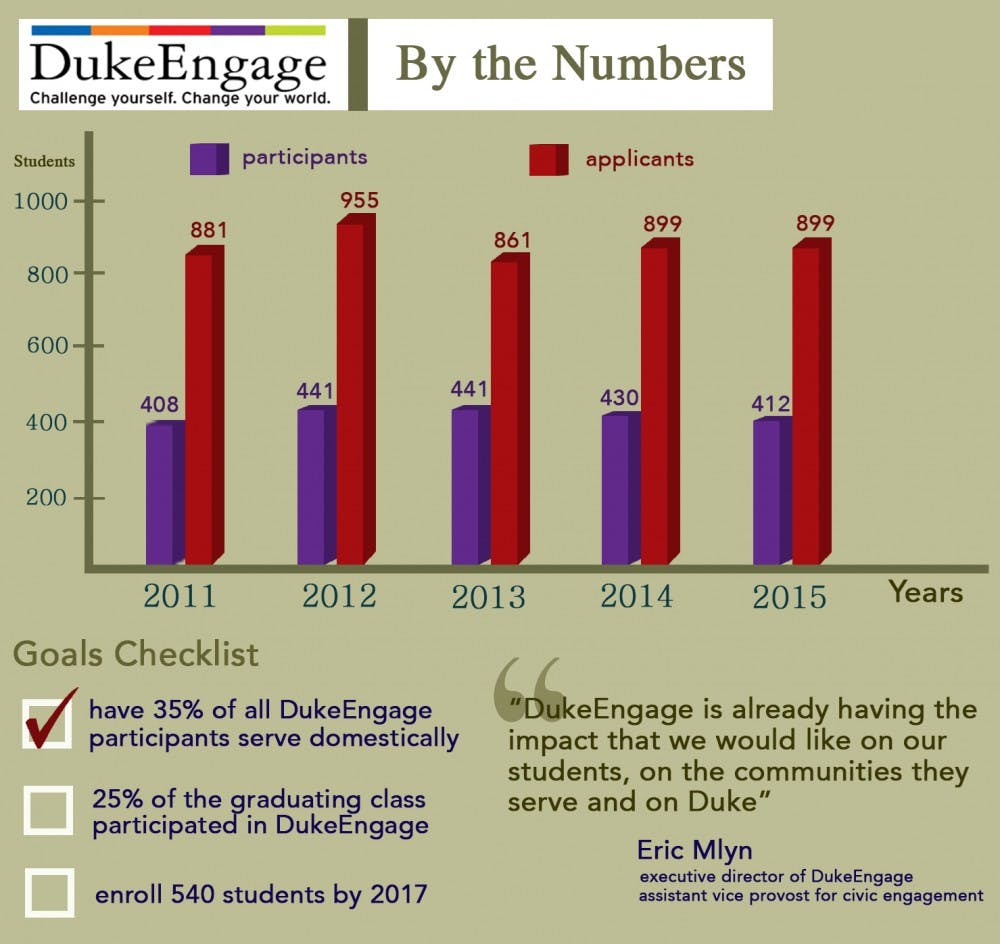Although DukeEngage continues to raise money, the program does not have “immediate plans” to incorporate more students overall into its programs.
Despite the financial resources of the program, which was launched in 2007, DukeEngage is not expecting a substantial increase in the number of students who can participate anytime soon, said Eric Mlyn, the Peter Lange executive director of DukeEngage and assistant vice provost for civic engagement. Participation numbers have held relatively steady in the past five years—408 students participated in 2011 and 412 participated in 2015. The strategic plan developed in 2013 initially recommitted the program to the goal of enrolling 600 students annually by 2017, but that goal has since been lowered to 540 students, Mlyn added.
Getting to that goal of 540, however, “would be hard,” Mlyn wrote in an email. He noted that the program has not been funding additional students in the past four to five years, adding that increasing those numbers remains a long-term, “aspirational” goal and that it is unclear where that funding would come from.
“We’re never losing sight of that goal, but it’s not going to happen next year,” Mlyn said.
DukeEngage is funded largely through a $30 million endowment fund comprised of a $15 million gift from the Bill and Melinda Gates Foundation and $15 million from the Charlotte-based Duke Endowment. Annual gifts from alumni and friends of the University as well as the University’s operating funds make up the rest of the program’s funding, Mlyn said.
“President Brodhead, Provost Kornbluth and Vice Provost for Undergraduate Education Steve Nowicki have been extraordinarily supportive and generous of DukeEngage,” Mlyn said. “We have no funding issues.”
The program’s endowment generates interest annually and is now worth more than $30 million, Mlyn said. The program’s strategic plan for 2017 called for an additional $20 million of funding to be raised as part of the DukeForward campaign—which Mlyn said has been raised and goes in part to annual spending and in part to the program’s endowment. DukeEngage spends more than $4 million annually, he added.
Roughly two to four programs have been added to DukeEngage each year, while simultaneously other programs have dropped out or dropped to an every other year cycle, Mlyn said. DukeEngage has been focused on reallocating students based on specific program demands rather than providing more student opportunities overall. Before 2011, adding a program typically meant allowing more students overall to participate in DukeEngage, he noted.
Adding a program itself does not typically lead to increased costs for DukeEngage, Mlyn explained.
“We’re not buying real estate or building infrastructure,” Mlyn said. “We’re using infrastructure that’s already there. New programs do not in and of themselves create a financial burden for us.”
Although DukeEngage has added more programs, it has seen an overall decline in student participants over the past two years—from a high of 441 students participants in 2013 to 430 in 2014 and 412 in 2015. Mlyn attributed the decline to programs being cancelled for security reasons and students dropping out at the last minute such that their spots could not be filled.
Major gifts from donors could allow DukeEngage to accept more students, but the University is limited in its own ability to increase student numbers, he said, especially given how much support it currently provides. He added that Duke’s support goes above and beyond what other universities often provide to similar civic engagement programs.
Although DukeEngage is unlikely to reach its student totals projected in its 2017 strategic plan, it has achieved some of its other goals. The plan called for 35 percent of all DukeEngage participants to serve domestically—an increase from 25 percent five years ago—which Mlyn said has been achieved.
“We feel we have an ethical obligation to be more involved in the United States,” he said, adding that DukeEngage is not planning to further increase that percentage.
DukeEngage is also near its goal of having 25 percent of all Duke graduating students to have participated in the program, according to an October article in The Chronicle. Mlyn added that part of the reason for revising projections from 600 to 540 students was to “more accurately reflect” the 25 percent target.
Although adding more students is desirable, he said, the program is comfortable with its current status.
“DukeEngage is already having the impact that we would like on our students, on the communities they serve and on Duke,” he wrote. “But to the extent that the growth would allow us to serve more qualified students and communities, that is one of our great aspirations.”
The Chronicle communicated with Mlyn on the phone and via email.
Get The Chronicle straight to your inbox
Signup for our weekly newsletter. Cancel at any time.

